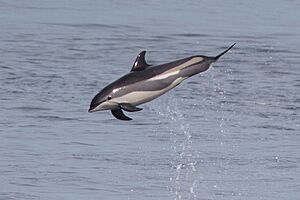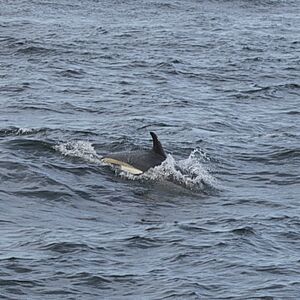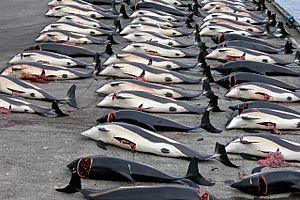Atlantic white-sided dolphin facts for kids
Quick facts for kids Atlantic white-sided dolphin |
|
|---|---|
 |
|
 |
|
| Size compared to an average human | |
| Conservation status | |
| Scientific classification | |
| Genus: |
Lagenorhynchus
|
| Species: |
acutus
|
 |
|
| Atlantic white-sided dolphin range | |
The Atlantic white-sided dolphin (Lagenorhynchus acutus) is a colorful dolphin that lives in the cool waters of the North Atlantic Ocean.
Contents
What Do They Look Like?
Atlantic white-sided dolphins are a bit stockier than other ocean dolphins. They look a lot like Pacific white-sided dolphins, even though they are not closely related.
When they are born, baby dolphins are just over a meter long. Adult males can grow to about 2.8 meters (9.2 feet) long. Females are a bit smaller, reaching about 2.5 meters (8.2 feet). They weigh between 180 and 230 kilograms (400-510 pounds) when fully grown.
Females can start having babies when they are 6 to 12 years old. Males are ready to mate between 7 and 11 years old. A mother dolphin carries her baby for 11 months. She then nurses it for about 18 months. Atlantic white-sided dolphins can live for at least 17 years.
Their Unique Colors
These dolphins have special markings that make them stand out. They have a white to pale-yellow patch behind their dorsal fin on both sides. This yellow patch is very unusual for dolphins.
Their body colors are very clear and distinct. Their chin, throat, and belly are white. Their flippers, dorsal fin, and back are dark gray to black. There is also another white patch below the dorsal fin. A lighter, grayish stripe runs from their beak, over their eye, and down to their tail.
Diet and Behavior
Dolphin groups, called pods, can be different sizes. Near Newfoundland, pods average around 60 dolphins. East of Iceland, they are usually smaller.
These dolphins mainly eat fish like herring and mackerel. They also enjoy squid. Atlantic white-sided dolphins are quite playful and like to swim near boats. However, they are not as outgoing as some other dolphins.
Where Do They Live?
These dolphins live only in the northern Atlantic Ocean. You can find them from the Norwegian Sea in the northeast to the Davis Strait in the northwest. They also live along the coast of North Carolina in the southwest and the Celtic Sea in the southeast. They might even go as far south as the Azores.
Many Atlantic white-sided dolphins live near Newfoundland and Cape Cod. They also like the area between the United Kingdom, Iceland, and Greenland. The northern North Sea is another popular spot.
They prefer colder, less salty waters. They often live in areas where the ocean floor drops steeply, like canyons.
How Do They Behave?
Finding Food
Atlantic white-sided dolphins mostly eat herring, hake, and squid. But they are also opportunistic, meaning they will eat many different kinds of prey. This includes smaller mackerel and fish that live near the ocean floor. They have been seen hunting together at the surface. Larger groups might split up when they are looking for food.
Social Life
Like all dolphins, Atlantic white-sided dolphins are very social. They often travel in large pods. They also love to jump and splash out of the water. Pods can have anywhere from a few dozen to several hundred dolphins. The average size is about 50.
Studies show that dolphins in a pod are usually not related to each other. They seem to travel together for safety. Young dolphins sometimes spend time in separate groups away from their parents. These dolphins jump and breach more when they are in bigger groups. This might be a way for them to socialize.
They make many different sounds, like squeals, whistles, clicks, and buzzes. They probably use these sounds to talk to each other, especially when they are socializing.
These dolphins are usually peaceful. They even interact with other types of dolphins in a friendly way, like the long-finned pilot whale. However, they have also been known to act aggressively towards harbor porpoises.
Traveling Habits
Atlantic white-sided dolphins do not have a specific migration season. Instead, they move around their home range to follow their food. For example, off the east coast of North America, they move south during winter and spring.
Having Babies
Most baby dolphins are born around June and July. The mother carries the baby for 11 months. She then nurses it for about 18 months. A mother dolphin usually has a new baby every 1 to 3 years.
Females become ready to have babies between 6 and 12 years old. Males are ready to mate between 7 and 11 years old. It seems that they mostly reproduce during certain times of the year, possibly starting in February.
Naming and Family Tree
The Atlantic white-sided dolphin was named by John Edward Gray in 1828. The name acutus means 'pointed' in Latin. This refers to their sharply pointed dorsal fin.
Scientists used to place this dolphin in the genus Lagenorhynchus. But new genetic evidence shows that the Atlantic white-sided dolphin and the white-beaked dolphin are actually quite different from other dolphins in that group. Because of this, some scientists have suggested moving the Atlantic white-sided dolphin to its own genus, called Leucopleurus.
How Many Are There?
Scientists estimate that there are about 300,000 Atlantic white-sided dolphins living off the U.S. coast. Another 120,000 are thought to spend their summers in the Gulf of St. Lawrence. In eastern North America, their numbers increase in the south during winter and spring.
Surveys have been done to count these dolphins. Some surveys combine white-sided and white-beaked dolphins, so it's hard to get an exact number for just the Atlantic white-sided dolphin. Other surveys have not shown any clear changes in their population numbers over time.
What Are the Dangers?
Hunting
In the past, Atlantic white-sided dolphins were hunted in Norway and Newfoundland. These hunts have mostly stopped now. However, some hunting still happens in the Faroe Islands. There, their meat and blubber are valued as food. The number of dolphins caught each year can vary a lot. For example, in 2002, 773 were caught, and in 2017, 488 were caught. In September 2021, a very large group of 1,428 dolphins was hunted in the Faroe Islands.
Getting Caught in Fishing Gear
Atlantic white-sided dolphins can also get accidentally caught in fishing nets. This has happened in Canada, the United States, the United Kingdom, and Ireland. They are sometimes caught in nets used for mackerel fishing or in large nets that float near the surface.
Noise Pollution
Loud noises underwater can bother Atlantic white-sided dolphins. They use sounds to communicate and find food. Surveys have shown that these dolphins are seen less often when loud airguns (used for oil exploration) are being fired.
Chemical Pollution
Harmful chemicals, like PCBs and flame retardants, have been found in the bodies of Atlantic white-sided dolphins. Males often have higher levels of these chemicals. This might be because females pass some of the chemicals to their babies when nursing. Heavy metals have also been found in these dolphins. Scientists are still studying how these chemicals affect the dolphins' health.
Conservation Status
The International Union for Conservation of Nature (IUCN) lists the Atlantic white-sided dolphin as a species of "Least Concern." This means they are not currently considered to be in danger of extinction.
The populations of these dolphins in the North and Baltic Seas are protected under the Convention on the Conservation of Migratory Species of Wild Animals (CMS). This means countries work together to protect them. They are listed because they would benefit from international cooperation.
The Atlantic white-sided dolphin is also covered by an agreement called ASCOBANS. This agreement helps protect small whales and dolphins in the Baltic, North East Atlantic, Irish, and North Seas.
See also
- List of cetaceans
- Marine biology




